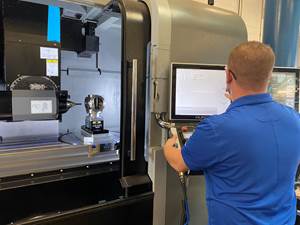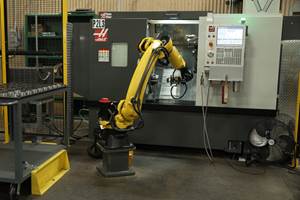When to Use 3+2 Versus Full Five-Axis for Finishing Operations
Consider the entire system — along with your goals — when deciding between a full five-axis or a 3+2 approach.
Share






Reader Question: We do a lot of work in mold, die and medical. When finishing complex surfaces on a five-axis machine, do you prefer three-axis motion or full five-axis?
Miller’s Answer:
Handling the more organic shapes in the mold, die and medical markets requires some careful consideration to strategy, tooling and tool paths. When done right, the result is a smooth surface that is accurate to the 3D model with minimal or no additional benchwork needed. When done wrong, it can look like a gouged mess and require a lot of processing time to polish out the mistakes. With the prevalence of five-axis machining today and the ease of programming with modern CAM systems, manufacturers have a lot more flexibility in how to approach these parts. However, care should still be taken to consider the entire system along with your goals when deciding between a full five-axis or a 3+2 approach.
Let’s first define the two strategies and their considerations. 3+2 finishing is when we position the tilt and rotary axes to an advantageous position and then execute a more traditional three-axis tool path with XYZ at that orientation. Full five-axis finishing refers to a tool path where the tilt and rotary are constantly moving with XY and Z to maintain an ideal angle between the tool and part surface at all locations. For some shapes and part types, the only option is full five-axis finishing, but for many others, either solution is adequate in terms of final results.
Pros and Cons of 3+2
There are several reasons why one would choose a 3+2 approach, even with modern options for full five-axis. A 3+2 strategy will generally produce the more predictable surface finish results as the machine is syncing fewer axes — and only the linear axes — as it chews through code. I say predictable not to imply better, but only to imply easier for the machine to execute. This means less potential for gouging, as the rotary axes are parked and there is less opportunity for slowing down and speeding up in tight areas, creating more consistent feed rates across the surface.
3+2 can be more cumbersome to program, as you need to potentially break a complex surface down to a few key areas and choose the right tilt and rotary position for each area to optimize tool performance like avoiding the null point of a ball nose. It can also create opportunities for mismatch where two of these areas, done with independent tool paths, must blend.
Pros and Cons of Full Five-Axis
Full five-axis surfacing has several advantages but relies heavily on a well-tuned system (machine, controller and programming) for success. Among the advantages is often simpler programming as one large surface can be machined and optimized within one tool path, which also contributes to improved blends and better tool performance. Full five-axis also enables the use of more exotic tool geometry, like lens forms and barrel cutters, to further optimize cutting time and resulting finishes.
Full five-axis programming requires a lot more processing power from your PC as tool paths will require very tight tolerances for the best results. This also requires the machine tool to have a suitable controller that can handle the code without hesitation as well.
How to Decide
If presented with a scenario where I could choose either, I would let the overall machine package and the part geometry inform my decision.
Five-axis machine tools have many options for driving the tilt and rotary axes from direct drives to gears, belts and many others. All have their benefits, but generally a machine designed for carrying high table weight requires slower, more robust gear drives, while a lighter-duty machine will be equipped with direct drives that excel in surfacing performance.
If the machine has direct drives on both the tilt and rotary, the choice is easy, as this setup is generally the most dynamic and capable of executing full five-axis motion. I would at least want the rotary axis to be direct drive, as it is responsible for most of the reversals needed to execute five-axis code. Therefore a gear or belt drive on the tilt axis would not impact the result as much. A machine with geared drives on both axes might struggle to execute code in a fast manner but would excel at handling weight. For some parts, this weight handling might also be an advantage towards the full five-axis approach as it’s less prone to overshoot or sag in the table.
Another way to decide is the part itself. If the five-axis motion needed to execute a surface is more sweeping and subtle in it’s angle and sudden changes then perhaps the impact of the machine tool is less important.
There is also the potential for a hybrid solution where the majority of a surface can be finished with the full five-axis approach, and only the tightest areas with the most challenging machine motion are left to a 3+2 approach.
If you’re unsure what your machine is capable of, you can do a test cut using both strategies. Set up a small test piece with geometry similar to the parts you commonly see and do both a 3+2 and a five-axis approach. Run the parts and compare them for things like surface finish, cut time and more intangible things like “Did the machine handle that well?” If the machine appears to struggle or shows hesitations executing the code, then maybe a simpler 3+2 approach is called for. If the surface looks good, then you’ve built some confidence in your machine’s capabilities and can adopt more five-axis tool paths in the future.
Do you have a machining question? Ask the expert. John Miller leans on more than a decade of industry experience to answer machining questions from MMS readers. Submit your question online at .
Related Content
Does a Five-Axis Machine Increase Business?
Five-axis machining is enabling custom fabricator Meyer Tool to take on more complex work and helping it produce less complex jobs more efficiently.
Read MoreInvesting in Automation, Five-Axis to Increase Production Capacity
To meet an increase in demand, this shop invested heavily in automation solutions and five-axis machines to ramp up its production capabilities.
Read MoreFive-Axis Machines Speed NASCAR Engine Production
Moving from an aging set of five-axis mills to more advanced machines enabled Hendrick Motorsports to dramatically improve its engine production.
Read MoreWhich Approach to Automation Fits Your CNC Machine Tool?
Choosing the right automation to pair with a CNC machine tool cell means weighing various factors, as this fabrication business has learned well.
Read MoreRead Next
Last Chance! 2025 Top Shops Benchmarking Survey Still Open Through April 30
Don’t miss out! Modern Machine Shop's Top Shops Benchmarking Survey is still open — but not for long. This is your last chance to a receive free, customized benchmarking report that includes actionable feedback across several shopfloor and business metrics.
Read MoreAMRs Are Moving Into Manufacturing: 4 Considerations for Implementation
AMRs can provide a flexible, easy-to-use automation platform so long as manufacturers choose a suitable task and prepare their facilities.
Read MoreMachine Shop MBA
Making Chips and Modern Machine Shop are teaming up for a new podcast series called Machine Shop MBA—designed to help manufacturers measure their success against the industry’s best. Through the lens of the Top Shops benchmarking program, the series explores the KPIs that set high-performing shops apart, from machine utilization and first-pass yield to employee engagement and revenue per employee.
Read More






















